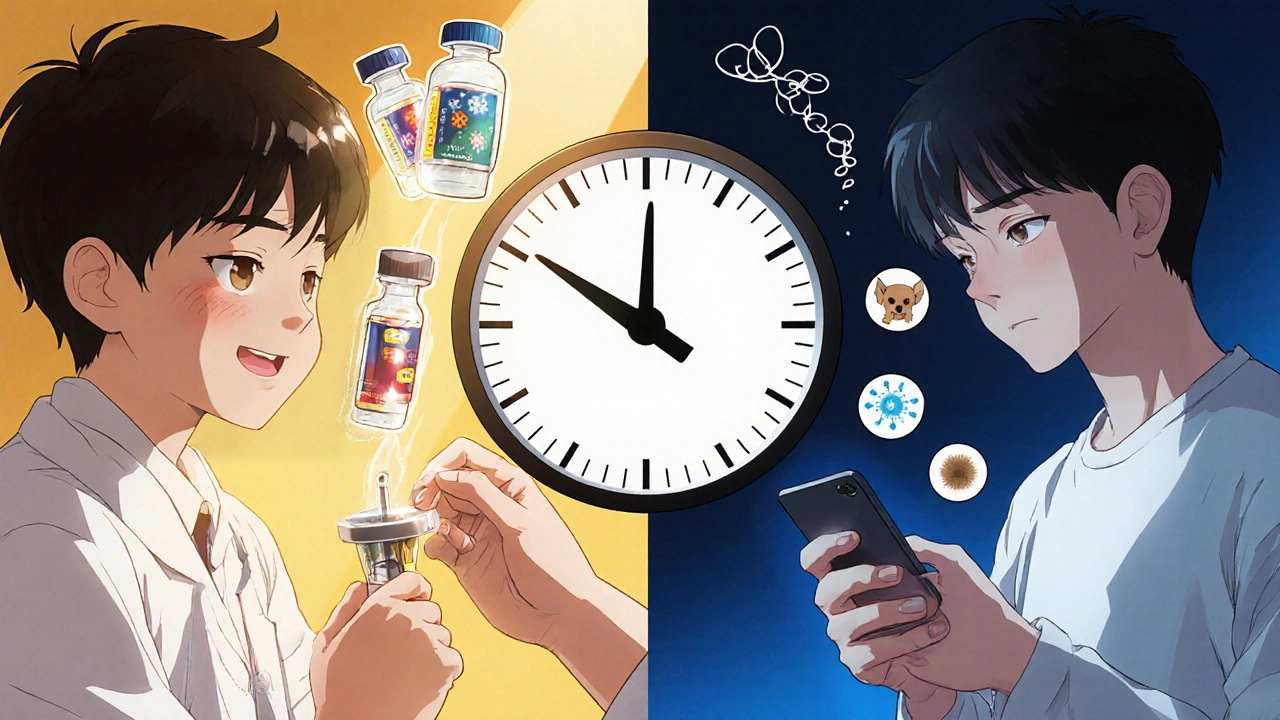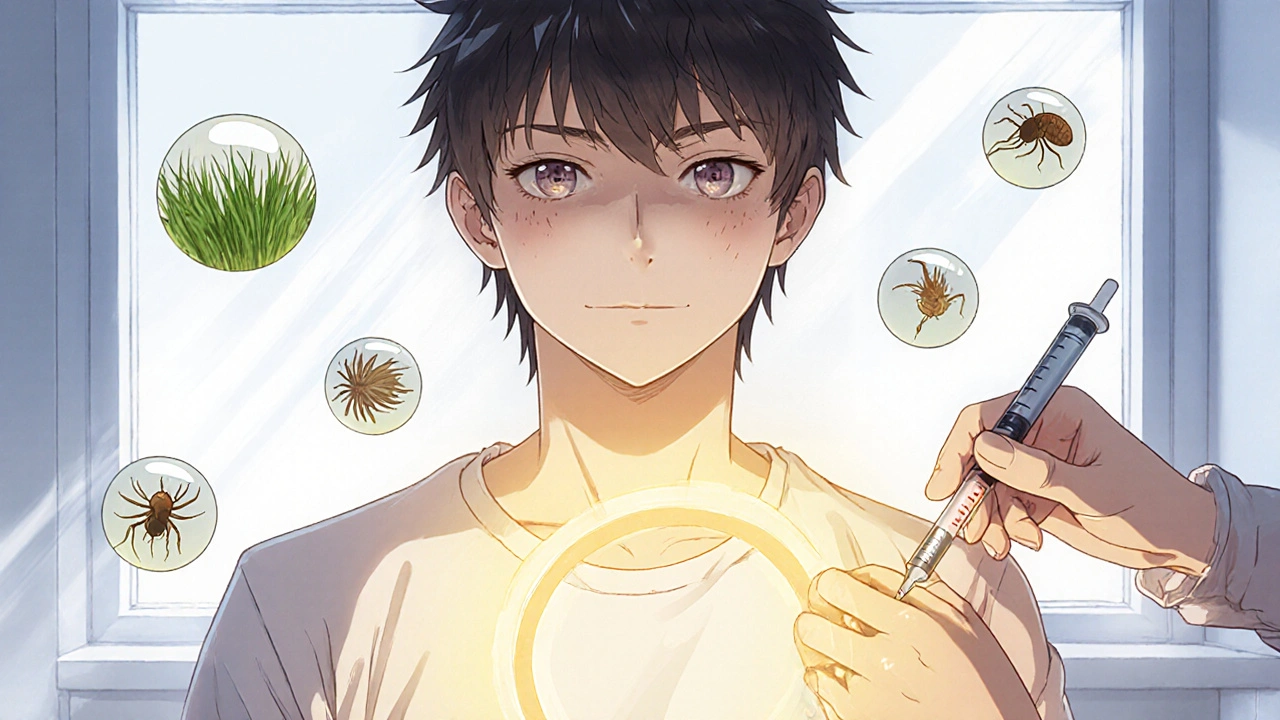For millions of people who suffer from seasonal sneezing, itchy eyes, or life-threatening bee stings, allergy shots and sublingual tablets aren’t just treatments-they’re a chance to reclaim normal life. Unlike antihistamines that mask symptoms, immunotherapy actually changes how your immune system reacts to allergens. It’s not a quick fix. It takes years. But for many, the results are permanent.
How Immunotherapy Works
Immunotherapy is built on a simple idea: expose your body to tiny, controlled amounts of what you’re allergic to-over and over-and eventually, your immune system stops overreacting. This isn’t new. The first allergy shots were given in London in 1911. Today, we know it works because it trains your body to produce ‘blocking’ antibodies instead of triggering histamine floods. The goal isn’t just to feel better during pollen season. It’s to stop the allergy from getting worse over time. Studies show immunotherapy can prevent new allergies from forming and even reduce the risk of developing asthma in kids with allergic rhinitis.
Allergy Shots: The Gold Standard
Allergy shots, or subcutaneous immunotherapy (SCIT), remain the most effective option for most people. They’re customized. Your allergist takes a vial with extracts of the specific things you’re allergic to-maybe grass, dust mites, cat dander, and ragweed-all mixed together. You get a small injection under the skin, usually in the upper arm. The process has two phases.
The first is the build-up phase. You start with very low doses and slowly increase them. Traditional schedules mean coming in 1-3 times a week for 3 to 12 months. But most clinics now offer cluster build-up: 8-10 visits over 4-9 weeks. Each visit takes about an hour, and you’re monitored afterward. For severe venom allergies, rush immunotherapy can get you to maintenance in just 6-16 weeks-done in one long day under close supervision.
Then comes maintenance. Once you hit the right dose, you space out shots to every 2-4 weeks. You keep this up for 3 to 5 years. The long-term payoff? About 85% of patients see major symptom improvement. Some stop needing meds entirely. The American College of Allergy, Asthma & Immunology says SCIT is the only treatment that changes the underlying disease process.
Sublingual Tablets: Convenience Without Compromise?
Sublingual immunotherapy (SLIT) tablets are a newer option. Instead of shots, you place a tablet under your tongue and let it dissolve. No needles. No clinic visits. Just daily use at home. The FDA has approved four tablets so far: Oralair and Grastek for grass pollen, Ragwitek for ragweed, and Odactra for dust mites. In April 2024, Cat-PAD became the first tablet approved for cat dander.
Each tablet targets just one allergen. That’s the big catch. Most people are allergic to more than one thing. Research shows 78% of allergy sufferers react to three or more allergens. If you’re allergic to both grass and dust mites, you’d need two different tablets. That’s expensive. And there’s no combo tablet on the market yet.
Effectiveness is solid-but not as strong as shots. Studies show SCIT reduces symptoms by 82% in multi-allergen patients. SLIT tablets? Around 67%. One Reddit user, after two years of Grastek with only 30% improvement, switched to shots and got 80% relief. That’s not rare. But for people who travel often, have busy schedules, or hate needles, the convenience is worth the trade-off.

Side Effects and Safety
Allergy shots carry a small risk of allergic reaction. Most are mild-redness, swelling at the injection site. But systemic reactions (like trouble breathing or swelling in the throat) happen in about 2-5% of cases. That’s why you have to wait 30 minutes after each shot. Cluster and rush protocols have slightly higher reaction rates, but modern clinics are equipped to handle them.
Sublingual tablets are safer overall. The most common side effect is an itchy mouth or throat-happens in nearly 30% of users. It usually fades after a few weeks. Severe reactions are rare. But if you have asthma or a history of severe allergic reactions, your doctor may not recommend SLIT. You’re on your own to manage side effects at home.
Who Gets the Best Results?
If you’re allergic to multiple things-pollen, mold, pets, dust mites-shots are your best bet. They’re the only option that can treat several allergens at once. If you have severe symptoms that don’t respond to meds, shots offer the strongest long-term relief.
Sublingual tablets are ideal for people with a single, well-defined allergy-like grass pollen-who want to avoid needles and clinic visits. Travelers, parents of young kids, or people with inflexible schedules often prefer them. But if you’re allergic to five things and only take one tablet, you’re still suffering from the other four.

Cost, Access, and Real-World Challenges
Allergy shots cost more upfront because of clinic visits, staff time, and the need for allergist supervision. But most insurance plans cover them well. Sublingual tablets are pricier per month, but you don’t pay for office visits. Over 3-5 years, the total cost can be similar.
Access is a bigger issue. In the U.S., there are only about 5,300 board-certified allergists. Many rural areas have none. If you can’t get to a clinic, shots aren’t an option. That’s why SLIT use is growing-even though it’s less effective for complex cases.
Adherence matters. For shots, you miss one appointment? You might fall behind, but you can catch up. For tablets, if you skip a day, you lose effectiveness. Studies show patients who take less than 80% of their doses get only 45% of the benefit. Setting phone reminders boosts adherence by 37%.
What’s Next?
The future of immunotherapy is getting smarter. In 2025, we’ll likely see the first multi-allergen sublingual tablets hit clinical trials. If they work, they could change everything. Researchers are also testing peptide-based therapies that might cut treatment time from 5 years to just 1-2.
Another shift: allergists are using component-resolved diagnostics-testing for specific proteins in allergens, not just whole extracts. This lets them tailor shots more precisely. You’re not just allergic to ‘grass.’ You’re allergic to a specific protein in rye grass. That precision improves results and reduces side effects.
For now, the choice comes down to this: Do you want the strongest possible outcome, even if it means weekly visits? Or are you willing to accept slightly less effectiveness for the freedom of daily tablets at home?
Real Stories, Real Results
One man in Ohio, allergic to dust mites, grass, and tree pollen, tried SLIT for a year. He still needed nasal sprays and antihistamines. He switched to allergy shots. By year two, he stopped all meds. His kids noticed-he could finally play outside with them without sneezing.
A woman in Colorado, a freelance photographer who traveled every month, couldn’t commit to weekly shots. She started Odactra for dust mites. She still had seasonal symptoms from pollen, but her year-round congestion dropped by 70%. She calls it a ‘partial win’-but a win, nonetheless.
There’s no one-size-fits-all. But the data is clear: if you’re serious about getting rid of allergies for good, allergy shots are still the most powerful tool we have.
Are allergy shots worth the time and effort?
Yes, if you’re allergic to multiple things or have symptoms that meds don’t control. Allergy shots are the only treatment proven to change your immune system’s response long-term. Most people see major improvement after 2-3 years, and many stay symptom-free for years after stopping treatment. The upfront time investment pays off in freedom from daily meds and better quality of life.
Can I switch from sublingual tablets to allergy shots?
Absolutely. Many people start with tablets for convenience and switch to shots when they realize their symptoms aren’t fully controlled. There’s no medical barrier to switching. Your allergist will assess your current allergy profile and design a new shot regimen based on what you’re still reacting to. Some patients even continue tablets while starting shots for additional allergens.
Do allergy shots hurt?
They feel like a quick pinch-similar to a flu shot. Most people describe it as barely noticeable. The discomfort isn’t the issue; it’s the time commitment and the need to sit in the clinic for 30 minutes after each shot. The real challenge is sticking with it for 3-5 years, not the injections themselves.
How long before I feel better?
You might notice slight improvement during the build-up phase, but real results usually come after 6-12 months on maintenance. For many, the biggest change happens in year two. By year three, most people report being able to go outside without sneezing, not needing nasal sprays, and sleeping better. Patience is key-it’s not a quick fix.
Are sublingual tablets covered by insurance?
Most U.S. insurance plans cover FDA-approved sublingual tablets, but copays can be high-sometimes $50-$100 per month. Unlike allergy shots, which are billed as a medical service, tablets are often classified as prescription drugs, which can affect coverage. Always check with your insurer and ask if they require prior authorization.
Is immunotherapy safe for children?
Yes. Both allergy shots and sublingual tablets are approved for children as young as 5. In fact, starting early can prevent allergies from worsening and reduce the chance of developing asthma. Many parents prefer tablets for kids because they’re needle-free. But shots are often more effective for children with multiple allergies or severe symptoms.
What happens if I stop immunotherapy early?
If you stop before 3 years, you’re unlikely to get lasting benefits. Most people start to relapse within a year. The immune system needs the full 3-5 year course to relearn how to respond. Stopping early means you’re back to square one-relying on meds again. If you’re struggling with adherence, talk to your allergist about cluster build-up or switching to tablets. Don’t quit without a plan.

